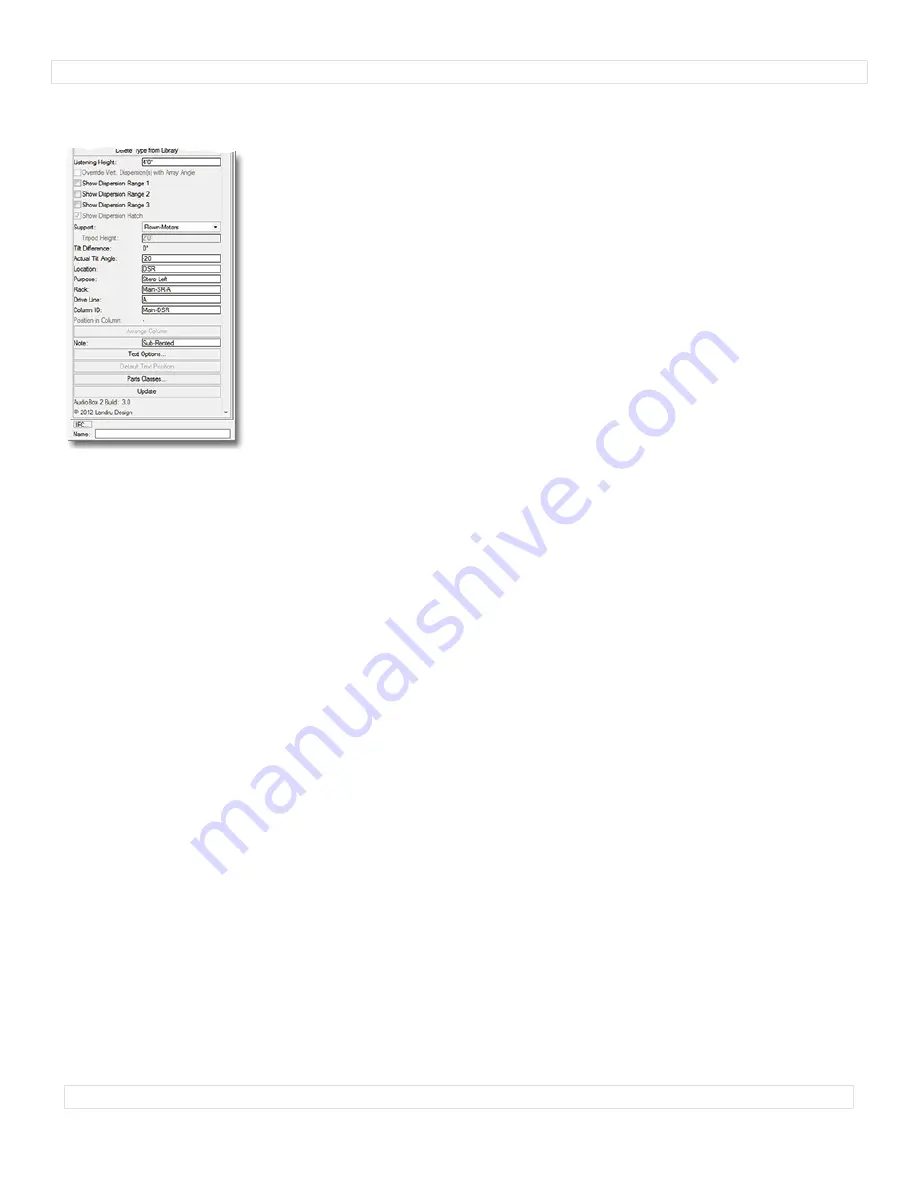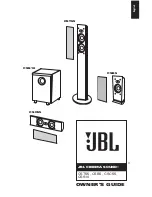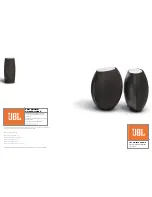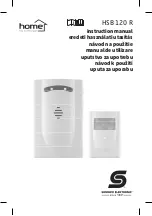
A
u
d
i
o
T
o
o
l
S
e
t
3
.
0
AudioBox 2
parameters, continued...
Listening Height:
The listening height reference for the dispersion lines.
(
Listening Height
cannot be higher than a given
AudioBox 2 model’s “Z” value.)
Override Vert. Dispersion(s) with Array Angles:
Will use
Angle Relative...
angle instead of stated
Vertical Dispersion
angles when drawing Dispersion lines.
(See
Tilt Difference
below and
Angle Relative...
on page15 for more
information. Only enabled if the AudioBox 2 instance has been placed by AudioArray 2.)
Show Dispersion Range 1
,
Show Dispersion Range 1
, and
Show Dispersion Range 1
: Draws top, bottom, left, and
right dispersion lines, and a center reference for each of the three Dispersion ranges. Also, an outline and hatch
representing the listening area coverage “shadow” will be drawn if the
Vertical Dispersion
angle,
Throw Distance
,
and
Tilt Angle
allow the loudspeaker to cover the
Listening Height
or below.
(The toggles for
Range 2
and
Range 3
are only enabled if
Expand Dispersion Features
is toggled on.)
Show Dispersion Hatch
: Adds a hatch pattern to represent the listening area coverage “shadow” if the
Vertical Dispersion
angle,
Throw Distance
, and
Tilt Angle
of any of the enabled ranges allow the loudspeaker to cover the
Listening
Height
or below, in addition to the “shadow’s” outline.
(Only enabled if one of the Dispersion Ranges is shown.
See
Show Dispersion Range 1
,
Show Dispersion Range 2
, and
Show Dispersion Range 3
, above.)
Support
: A pop-up menu of support options. While the other options are reference-only, if “Tripod” is selected,
AudioBox
2
will create a tripod floor stand.
(Only available if “Ceiling Speaker” is NOT selected.)
Stand Height
: The height of the floor stand.
(Only enabled if “Ceiling Speaker” is NOT selected and only if the “Tripod”
“Support” is selected.)
Tilt Difference
: The tilt difference between the selected loudspeaker and the bumper or loudspeaker above it, once the
Arrange Column
button has been clicked - or as determined by the
AudioBox 2
object’s being placed by
AudioArray
2
.
(Only available if “Ceiling Speaker” is NOT selected.)
Actual Tilt Angle:
The actual tilt of the loudspeaker.
(Only available if “Ceiling Speaker” is NOT selected. Negative
numbers tilt the cabinet down; positive, up.
AudioBox 2 will not allow the loudspeaker to tilt more than 90° or less
than -90°
.)
Location:
A place for entering the loudspeaker location (such as Downstage Right).
Purpose:
A place for entering the loudspeaker purpose (such as Center Fill).
Rack:
A place for entering information about the rack driving the loudspeaker.
Drive Line:
A place for entering information about the drive line feeding signal to the loudspeaker.
Column ID:
The name for the column (if any) in which the
AudioBox 2
object is placed. This is also the name for the
AudioArray 2
“parent”/“master’ bumper and the “child”/“slave” loudspeaker. This is how the Plug-In Object knows
which loudspeaker or additional models to control - either via the
Arrange Column
button
(see below)
or the
AudioArray 2
PIO.
(Only available if “Ceiling Speaker” is NOT selected.)
Position in Column
: The loudspeaker’s position in its column, once the
Arrange Column
button has been clicked or the
AudioBox 2
object has been placed or updated by an
AudioArray 2
object..
(Only available if “Ceiling Speaker” is
NOT selected. “1" is the top loudspeaker.)
Arrange Column
(button)
:
If multiple
AudioBox 2
objects are selected, each with different “Z” values - but with matching
Column ID
s, clicking this button will adjust the stacking order so that 2D “overlaps” are correct, calculate
Tilt
Differences
, and assign
Position in Column
numbers.
(Only available if “Ceiling Speaker” is NOT selected.)
Note:
A place for entering miscellaneous notes, such as rental source or stock number.
Text Options...:
A button to open the “Text Options” dialog, in which text elements are shown, hidden, and/or modified.
(See page 17 for more information)
.
Default Text Position:
A button to return text to its default location.
(Only enabled if text has been inserted.)
Parts Classes...:
A button to open the “Parts Classes” dialog, used to assign the different elements comprising the
AudioBox 2
model to different Classes..
(See page 17 for more information.)
Update
(button): Click this button to regenerate the
AudioBox 2
object. You might need to click this if you’re making
changes regarding using Class Attribute settings.
AudioBox 2 Build:
The build number of the
AudioBox 2
Plug-In Object code.
p
a
g
e
1
0
o
f
1
9





































